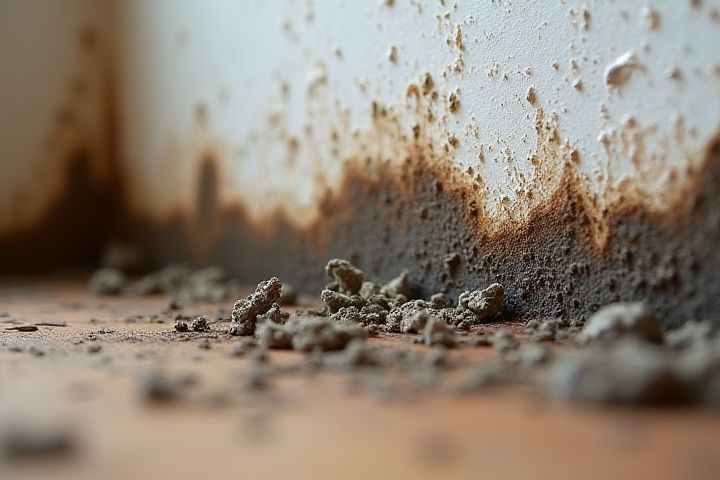
House mold growth is primarily caused by excessive moisture in the environment, often due to poor ventilation, water leaks, or high humidity levels. Common sources of moisture include plumbing issues, condensation from HVAC systems, and damp basements. Mold thrives in warm, dark areas such as behind walls, under sinks, or in bathrooms where humidity is frequently high. To prevent mold development, it is crucial to manage indoor humidity levels below 50% and ensure proper air circulation. Regular inspections and timely repairs of water leaks can significantly reduce the risk of mold infestation in your home.
What Causes House Mold Growth
Excess humidity
Excess humidity, typically over 60%, provides an ideal environment for mold growth within your home. This elevated moisture level can originate from various sources, such as leaks, inadequate ventilation, or indoor activities like cooking and showering. When the relative humidity remains high, mold spores in the air settle on surfaces, thrive, and can proliferate rapidly within 24 to 48 hours. Controlling humidity levels through dehumidifiers or proper ventilation is essential for preventing mold infestations and ensuring a healthier living space.
Poor ventilation
Poor ventilation is a primary cause of house mold growth, as it creates a damp environment where moisture accumulates. When air circulation is insufficient, humidity levels can rise above 60%, providing an ideal breeding ground for mold spores. Areas such as attics, basements, and bathrooms often suffer from this issue, leading to visible mold formation within just 24 to 48 hours under the right conditions. To combat mold growth, ensure that your home has proper airflow through exhaust fans, open windows, and dehumidifiers to maintain a healthy indoor environment.
Water leaks
Water leaks are one of the primary causes of house mold growth, as mold thrives in damp environments. A small leak from pipes, roofs, or windows can create moisture, providing an ideal breeding ground for mold spores. According to the CDC, mold can develop within 24 to 48 hours after water exposure, emphasizing the urgency of addressing leaks promptly. Regular maintenance and timely repairs of plumbing systems and insulation can significantly reduce your risk of mold-related health issues and structural damage.
Flood damage
Flood damage significantly contributes to house mold growth by creating a damp environment conducive to mold spores. When water infiltrates a home, it saturates materials such as drywall, wood, and carpets, leading to high humidity levels. Mold thrives in conditions where the moisture content exceeds 60%, often developing within 24 to 48 hours if not properly addressed. To mitigate mold formation, it is essential to remove water-damaged materials and promptly repair leaks, ensuring your home remains dry and well-ventilated.
Condensation
Condensation plays a significant role in house mold growth, particularly in areas with high humidity levels. When warm, moist air meets cooler surfaces, such as windows, walls, or ceilings, it cools down and releases moisture, creating ideal conditions for mold spores to thrive. Over time, even small amounts of condensation can lead to dampness, providing a suitable habitat for mold species to proliferate. To prevent mold growth, it's essential to maintain indoor humidity between 30% and 50% and ensure proper ventilation in your home.
Damp building materials
Damp building materials are a primary catalyst for house mold growth, as mold thrives in moist environments. When materials like wood, drywall, or insulation become saturated, typically due to water leaks or poor ventilation, they provide an ideal substrate for mold spores to flourish. The presence of humidity levels above 60% can exacerbate this issue, facilitating rapid mold proliferation within 24 to 48 hours. Regularly monitoring moisture levels and maintaining proper airflow in your home can significantly reduce the risk of mold growth linked to damp materials.
Inadequate insulation
Inadequate insulation can lead to significant house mold growth, primarily by allowing unwanted moisture accumulation. Poorly insulated walls can trap humidity, creating optimal conditions for mold spores to thrive, especially in areas with high relative humidity, often above 60%. Without proper insulation, temperature fluctuations can result in condensation, particularly on cooler surfaces, contributing to mold proliferation. To combat this, investing in high-quality insulation can help maintain stable temperatures and reduce moisture levels, creating a less inviting environment for mold in your home.
Poor drainage
Poor drainage significantly contributes to house mold growth by allowing excess moisture to accumulate in and around your home. When water fails to flow away effectively from foundations, basements, or crawl spaces, it creates a damp environment that fosters mold spores. The presence of standing water or consistently wet surfaces can lead to mold infestations within 24 to 48 hours. Ensuring proper grading, using gutters and downspouts, and implementing drainage systems can reduce this risk and protect your living space from mold-related issues.
Organic materials
Mold thrives on organic materials such as wood, drywall, and fabric, which provide essential nutrients for its growth. When these materials become damp, often due to water leaks, high humidity, or poor ventilation, mold spores can quickly colonize and proliferate. For instance, studies indicate that humidity levels above 60% can create an ideal environment for mold, leading to increased risks of infestations. Regular inspections and moisture control measures are vital in preventing mold development on these organic surfaces in your home.
High indoor temperature
High indoor temperatures, typically above 70degF (21degC), create an ideal environment for mold growth, as most mold species thrive in warm conditions. When the air is warm, it can hold more moisture, increasing humidity levels indoors and often reaching above the 60% threshold that promotes mold proliferation. Poor ventilation in combination with elevated temperatures traps moisture, further exacerbating the problem, especially in areas like bathrooms and kitchens. To prevent mold, maintaining indoor temperatures around 68degF (20degC) and ensuring adequate airflow can significantly reduce humidity and the risk of mold development.
